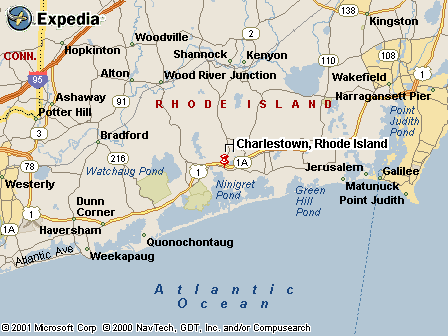|
|
Canku Ota |
|
|
(Many Paths) |
||
|
An Online Newsletter Celebrating Native America |
||
|
November 3, 2001 - Issue 48 |
||
|
|
||
|
Second Graders Walk in Native American Moccasins |
||
|
by Beatrix Mattyasovszky-Block Island Times-October 20, 2001 |
 Nine eager second
graders, accompanied by teacher Barbara Michel, visited the Parker Woodland Wildlife Refuge, a 900-acre parcel
owned by the Rhode Island Audubon Society in Coventry, to learn about what life was like in a Narragansett Native
American village. The trip augments their thematic unit on Native Americans. Nine eager second
graders, accompanied by teacher Barbara Michel, visited the Parker Woodland Wildlife Refuge, a 900-acre parcel
owned by the Rhode Island Audubon Society in Coventry, to learn about what life was like in a Narragansett Native
American village. The trip augments their thematic unit on Native Americans.Gathered in a circle, as the Narragansetts did, students participated in a lively talk about the traditions and history of the Indians. Their prior knowledge was evident as they answered many questions about what the Indians ate, what they lived in and what tools they used. When Audubon guide Chris Hitchener asked what the Narragansetts might eat during the summer when they lived on the beach, it was clear where these students were from, as they fired out answers one after the other. "Lobster!" cried one. "Scallops!" "Clams!" "Bluefish!" "Quahogs!" chorused the others. They also knew quite a bit about the farming methods and, with the help of Hitchener, participated in their own Narragansett planting ceremony. Students pretended they were the "three sisters," beans, corn and squash, and learned how the Narragansetts believed the vegetables should be planted together. Beans, the "weak sister," so named because it needs a support system to grow, contains a natural fertilizer and helped the corn to grow. Corn, "the tall sister," held up the beans, and squash, the "fat sister," prevented weeds from growing and choking the other two. As the Narragansetts did, the students painted their faces with colors that symbolized things in nature. To the Narragansetts, blue represented water; yellow, the sun; green represented photosynthesis; brown for dirt; red for blood which represents life; black for death; and white the Great Spirit, which looked after the Indians and their crop. The second graders were then told to walk quietly and in single file, so as not to alert any potential enemies or scare potential game, from the lodge where they gathered to a small clearing abutting a large grassy meadow which shone a brilliant gold in the October sun. They dug in the earth with their quahog shells, creating small mounds where the seeds would be planted. The corn seed was planted first, on the top; the bean seed in the middle on the side of the mound; and lastly the squash, planted on the base of the mound. To ensure a successful crop and to honor the directional spirits, a prayer was conducted after each mound was planted. With Hitchenerís guidance, the students happily chanted: "North is where my strength is," and "East is where my intelligence is," and "South is where my soul is," and "West is where the Great Spirit is." Next, the students enjoyed the Native American snack of popcorn as they listened intently to a story about an arrogant young Indian named Gluscabi, who learned the value of patience in his quest to become a great hunter by listening to the wise words of his Grandmother Woodchuck. Stories like these were told as part of a celebration ceremony after the fields were planted, according to Hitchener. The celebrations were held in the longhouses of the Narragansetts, where many families would live. The Narragansetts, whose population is estimated to have been 35,000 before the arrival of the white settlers, also lived in wigwams, and the students visited a mock wigwam on the premises. There they gathered, after a stealth walk through the woods, to hear about the homeopathic remedies the Narragansetts employed. The students chuckled when they heard that the Narragansetts didnít use a toothbrush, but chewed on gray birch or bayberry to keep their teeth clean. Sphagnum moss, with its naturally occurring antiseptic, was put in deerskin diapers to prevent rash. Sassafras roots were boiled in a tea for curing headaches. From the wigwam, the class trooped through the woods, then stopped for a Narragansett camouflage game that resembled hide-and-go-seek. Eager pleas by the students for yet another round of the game had to be denied; the bus and the ferry awaited the students. Their walk departing the woods was not so stealth, as the excitement of a fun and educational day away from the classroom was hard to contain. |
|
|
|
Narragansett Tribe |
|
Narragansett History |
|
|
||
|
|
||
| Canku Ota is a free Newsletter celebrating Native America, its traditions and accomplishments . We do not provide subscriber or visitor names to anyone. Some articles presented in Canku Ota may contain copyright material. We have received appropriate permissions for republishing any articles. Material appearing here is distributed without profit or monetary gain to those who have expressed an interest. This is in accordance with Title 17 U.S.C. section 107. | ||
|
Canku Ota is a copyright © 2000, 2001 of Vicki Lockard and Paul Barry. |
||
|
|
|
|
|
The "Canku Ota - A Newsletter Celebrating Native America" web site and its design is the |
||
|
Copyright © 1999, 2000, 2001 of Paul C. Barry. |
||
|
All Rights Reserved. |
||

